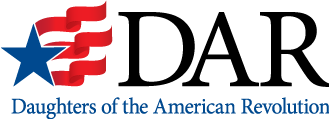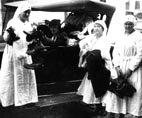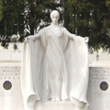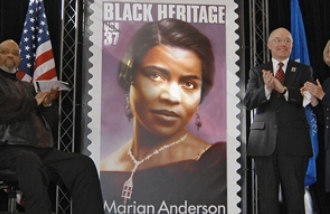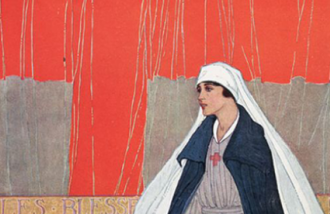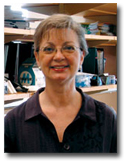
Volume 143, Number 5, September/October 2009, Page 4–5
By Lena Anthony
Meet three Daughters with a common bond—a dedication to improving the health and wellness of women.
Most people know that Breast Cancer Awareness Month is in October, but did you know there’s such a thing as National Women’s Health Week or National Osteoporosis Awareness and Prevention Month? In fact, almost every week of the year is dedicated to the observance of at least one women’s health issue. Such a national focus on women’s health has come to the forefront only in the last 25 years, partly because of the life-saving efforts of Daughters like Deborah Dillon, Peggy Doheny and April Sandmeyer, who have committed themselves through their careers and volunteer work to promoting the health and wellness of women.
Deborah Dillon, M.D.
Pathologist and breast cancer researcher
These are exciting times for breast cancer research, and in the center of it all is Dr. Deborah Dillon, assistant professor at Harvard Medical School and molecular genetic pathologist at Brigham and Women’s Hospital.
When breast cancer patients go to Boston’s Dana Farber Cancer Institute or Brigham and Women’s Hospital (an affiliate of Harvard Medical School) to see a surgeon, oncologist or radiation therapist, Dr. Dillon and her colleagues review slides from their biopsies, excisions and mastectomies to determine what type of breast cancer they have and how aggressive it is likely to be. They also identify the tumor’s other critical characteristics, such as hormone receptor expression and the status of a protein called HER2/neu.
“This information helps the surgeon decide whether margins need to be re-excised, whether they need to sample lymph nodes or to do any additional surgery,” she explains. “It also helps the radiation therapists decide whether to irradiate the breast and helps the oncologists decide on the best therapy for the patient.”
Gone are the days of one-solution-fits-all cancer therapy. Pathologists like Dr. Dillon help oncologists customize breast cancer therapy to the individual patient.
“The idea of tailoring therapies to the particular features of an individual patient’s tumor has really changed the paradigm in cancer medicine,” she says. “Right now, the expression of hormone receptors and HER2/neu by a patient’s tumor largely determines which therapies are likely to be successful in a patient. Since these therapies still fail to stop the cancer in some patients, researchers are continually working to discover even more specific molecular changes in tumors that can be targeted by specific drugs.”
When Dr. Dillon is not analyzing tissue under her microscope, she’s designing experiments to test new molecular markers in breast cancer, discussing results with colleagues and collaborators, and reviewing scientific literature. She also teaches residents and fellows at Brigham and Women’s Hospital and medical students at Harvard Medical School.
Dr. Dillon says debating diagnoses and treatment with her colleagues is one of the most rewarding parts of her job. “The most interesting research ideas come out of clinical discussions, usually of a challenging clinical diagnostic or treatment problem,” she says. “That’s exactly the sort of thing that needs to be addressed in the laboratory. What we discover in the lab can go back into the clinic to improve how patients with breast cancer are treated.”
Dr. Dillon is a member of the Piety Hill Chapter, Birmingham, Mich., and a wife and a mother to three active children. “Balance is a challenge,” she says. “Fortunately, my husband has always been supportive of my career and involved in our children’s lives. Our children understand that it has not been easy for me to make it to every school play and swim meet, but I think they have also learned from me the excitement of working at the frontiers of knowledge and the importance of helping others.”
Peggy Doheny, Ph.D.
Pioneer of osteoporosis research
It’s been almost 15 years since Peggy Doheny, Ph.D., a professor at Kent State University’s College of Nursing, began her research on osteoporosis, a bone disease that predominantly affects post-menopausal women. She’s proud of the strides she and her research team have made during that time, but she also knows there’s so much more to be done to help prevent this devastating disease—in both women and men.
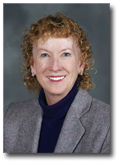 “Since we started our research, [understanding about] osteoporosis has become more mainstream,” she says. “Fifteen years ago, it was thought of as an old woman’s disease. But that’s just not true.
“Since we started our research, [understanding about] osteoporosis has become more mainstream,” she says. “Fifteen years ago, it was thought of as an old woman’s disease. But that’s just not true.
“When we would talk to men, they’d say, ‘Talk to my wife, not me.’ Now you see osteoporosis research focusing on men all the time. We were really on the leading edge back then.”
Dr. Doheny’s interest in osteoporosis developed when she was working as an orthopedic nurse at Kent State University Hospital, where she saw so many patients who were debilitated by hip fractures. “It was just devastating,” she says, “especially knowing it was something that probably could have been prevented.”
But prevention doesn’t come easily. “You can teach people about prevention, but changing behaviors is very difficult,” says Dr. Doheny, who is currently applying for a grant that would allow her to explore osteoporosis interventions, such as helping individuals increase their calcium intake and encouraging them to exercise more. Once the behavior is changed, the reward is great. “A man who participated in one of our studies contacted me after he found out he had low bone mass and told me I saved his life. It’s those kinds of things that make what I do fulfilling and worthwhile.”
Dr. Doheny has been recognized for the accomplishments she has made in her research career with awards from the National Association of Orthopaedic Nurses and invitations to share her research findings around the world, including in Japan and Singapore. She has even presented prevention tips to her fellow members of the Hannah Luther Bosworth Chapter, Strongsville, Ohio.
April Sandmeyer
A champion for her community’s health
April Sandmeyer is an advocate for her community’s health in various ways, many of which have gone unheralded. In 1995 she wrote a letter to the Avon Foundation on behalf of a women’s community center in Brooklyn, N.Y. That letter resulted in the center receiving a $100,000 grant to help minority women get free mammograms and treatment for breast cancer. Earlier this year, she took an elderly neighbor with a speech disorder to the hospital and stayed with her for more than 10 hours to help her communicate with the doctor. She has also paid rent, bought groceries, done laundry, cooked and cleaned for sick and elderly neighbors.
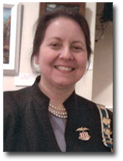 Ms. Sandmeyer is also a champion for diabetes prevention, a cause she began supporting when her best friend died from complications from the disease at age 28. “I have witnessed the horrors of the blindness and amputations due to diabetes,” she says. “It’s a really devastating illness that can be prevented or managed if people take care of their diets and exercise and get diagnosed early.” As a volunteer with the American Diabetes Association, she urges Congress to fund medical research and prevention programs, and she spreads the word about free preventive care available in New York City. Each year on World Diabetes Day, Ms. Sandmeyer lights up her apartment with blue lights, which symbolize diabetes awareness. “They do this all around the world every November 14,” she says. “It’s a very dramatic statement that gets people talking.”
Ms. Sandmeyer is also a champion for diabetes prevention, a cause she began supporting when her best friend died from complications from the disease at age 28. “I have witnessed the horrors of the blindness and amputations due to diabetes,” she says. “It’s a really devastating illness that can be prevented or managed if people take care of their diets and exercise and get diagnosed early.” As a volunteer with the American Diabetes Association, she urges Congress to fund medical research and prevention programs, and she spreads the word about free preventive care available in New York City. Each year on World Diabetes Day, Ms. Sandmeyer lights up her apartment with blue lights, which symbolize diabetes awareness. “They do this all around the world every November 14,” she says. “It’s a very dramatic statement that gets people talking.”
Ms. Sandmeyer has volunteered for numerous other causes, including the prevention and treatment of asthma, lung disease, AIDS and heart disease. She and her daughter Maya also spend one Saturday afternoon a month acting as ambassadors for the Leukemia and Lymphoma Society. “Two of my uncles died from leukemia, but that’s not why we got involved,” she says. “Every group we’ve joined has been due to a request for volunteers in the community. The need for volunteers has increased due to budget cuts caused by the economy.”
Her willingness to help others is also how she was introduced to DAR. “My neighbor, who was my mother’s best friend, had become too old to go to her DAR meetings by herself, and she asked me to accompany her,” she says. “I went to every single meeting she had for about five years.”
Ms. Sandmeyer, Regent of the Anne Hutchinson Chapter, Bronxville, N.Y., has encouraged her fellow Daughters to get involved in health causes as well. “One person alone can make a big difference,” she says, “but a group of us can really make a lasting impact.”
